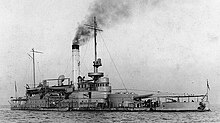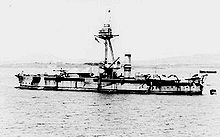Coastal armored ship
A coastal armored ship was a historical type of warship that was used to defend its own coastline (especially the ports) against attacking enemy naval units.
General
In the second half of the 19th century, armored ships that were designed for use in coastal areas were referred to as coastal armored ships . They should operate independently of the deep-sea fleet in the coastal apron and in the estuaries of large rivers, keep the way clear for their own fleet and fight enemy blockade forces. It was also intended to be used against deep-sea armored ships. Since coastal armored ships were specially designed for the respective operational area, it was hardly possible to compare the coastal armored ships of the different fleets with one another. The armament consisted mostly of two to four heavy and a number of light guns . The water displacement was between 3000 and 6000 tons . Since the fleets of the more important naval powers shifted their focus to ocean warfare at the turn of the 20th century, the coastal armored ships were removed from the fleet lists of most states during or after the First World War . Only in the Scandinavian countries were coastal armored ships in service until the end of the Second World War . In the Austro-Hungarian fleet, the ships of the Monarch class , known as coastal defenders , were used quite successfully in the Adriatic during the First World War ; they were considered successful constructions.
German Empire
In the Imperial Navy, the eight ships of the Siegfried class were designated as coastal armored ships . Built between 1889 and 1895, the ships, which were derisively called "guinea pigs" or "sea women" because of their sweeping hull shape, were to be used to protect the Kaiser Wilhelm Canal . Although the German coastal armor had enormous steel armor up to 24 cm thick, they suffered from various deficiencies, the largest of which was certainly the small radius of action . It was not until 1900 that the ships were extended by an 8.4 m long intermediate piece, which increased the coal supply and thus the range. The ships were in fleet service until 1909 and were then transferred to the reserve. At the beginning of the First World War, however, they were reactivated and the VI. Squadron under Rear Admiral Richard Eckermann , assigned from 1 September 1914 under Rear Admiral Herwarth Schmidt von Schwind . In 1916 they finally retired from active service in the fleet.
Technical data of the ships
- Ship class: Siegfried class
- Ships of the class (commissioned from 1890–1894):
SMS Siegfried , SMS Hildebrand , SMS Beowulf , SMS Hagen , SMS Frithjof , SMS Heimdall ,
slightly different (commissioned in 1896):
SMS Odin , SMS Agir - Crew: approx. 300 men
- Dimensions: length before conversion 79 m, after conversion 84.8 m - width 14.9 m - draft: 5.3 m
- Displacement: 4100 tons
- Machine power: 5000 hp
- Maximum speed: 15 kn
- Armament: 3 cannons caliber 24 cm, 10 rapid-fire cannons caliber 8.8 cm and torpedoes
- End: Retired as warships in 1919 and scrapped in 1920
Even before that, the Imperial Navy had the 9 coastal armored ships of the Wespe class with the main armament of a 30.5 cm cannon in service from 1876 , but they were decommissioned from 1900.
Similar ships of the great navies
Japan

The Imperial Japanese Navy did not have classic coastal armored ships built. Due to their successful wars, however, three ships of this type came into their possession and were used at times, albeit more to support attacks on naval bases than for defense. In the Sino-Japanese War , the Ping Yuen , built in China , was conquered and used as the Hei Yen after modernization . It was lost in 1904 by a mine hit off Port Arthur . In the Russo-Japanese War in 1905, the Japanese navy also captured the coastal armored ships Admiral Senjawin and General-Admiral Apraxin , which had been sent from the Baltic Sea to East Asia near Tsushima, and were then put into service as coastal defense ships Mishima and Okinoshima . Their first combat mission under the Japanese flag took place in 1914 against the German naval base in Tsingtau in China. At the end of the war, the Mishima supported the Japanese intervention in Siberia against the Red Army : the Mishima served as an icebreaker and kept the sea routes from Japan to Vladivostok open to supply the Japanese troops fighting there.
United States
The first armored ship of the United States Navy , the Monitor of almost 1,000 tons, was actually only designed for shallow waters and thus a coastal armored ship. It proved itself on March 9, 1862 in the Battle of Hampton Roads against Virginia in the first battle in naval history between iron-armored ships.
By 1864, the US Navy had many other ships of this type built. The first new building more in line with the European coastal armored ships was the Puritan from 1896 with a displacement of 6,060 t. It was followed in 1902/1903 by the four monitors of the Arkansas class of 3,225 t, 12.5 kn and an armament of two 30.5 cm L / 40 cannons in a double turret. Originally named after American states, the ships changed their names in 1908 as the state names were used for battleships.
United Kingdom
The British Royal Navy procured Rendel gunboats , as well as monitors similar to the US ships.
In particular the monitors HMS Magdala (3340 tn.l.) and HMS Abyssinia (2900 tn.l.) in Bombay , as well as HMVS Cerberus (3340 tn.l.) in Melbourne, were supposed to take on coastal defense tasks. 1872 to 1877 followed other ships with HMS Glatton (4910 tn.l.), HMS Rupert (5440 tn.l., guard ship in Hull 1885–1890, Pembroke 1893–1895, Gibraltar 1895–1902, Bermuda 1904–1907) and the four ships of the Cyclops class (3480 tn.l., Cyclops , Gorgon , Hecate , Hydra , all launched in 1871) and the two ships of the Conqueror class (6200/6440 tn.l., Conqueror and Hero , 1881 and 1881 respectively . Launched in 1885). The last six ships were mostly in reserve.
It was not until World War I that the Royal Navy developed similar types again and procured several series of monitors to support the land forces at sea. The four ships of the Abercrombie class , the eight of the Lord Clive class and the two ships of the Marshal Ney class deserve special mention . In addition, in 1918 the Royal Navy took the coastal armored ships of the Bjørgvin class , HMS Glatton (ex Bjørgvin ) and HMS Gorgon (ex Nidaros ) under construction for Norway at the start of the war in the United Kingdom into service.
There were combat missions of such ships with ships in 1915 when the British Navy decided to use two of the monitors originally built for Brazil for use on the Amazon , HMS Mersey and HMS Severn , to destroy the SMS Königsberg located in the Rufiji Delta .
A very one-sided battle broke out on January 20, 1918, when the Turkish fleet with the former German ships Yavuz Sultan Selim and Midilli broke out of the Dardanelles, surprised the British security units at Imbros and sank the HMS M28 and HMS Raglan monitors , with 138 Man found death.
Coastal armored ships from other countries
- ARA Libertad (1890) and ARA Independencia (ex ARA Nueve de Julio, 1891) - 2,336 tn. l.
- Tordenskjold (1880) - 2,530 tons l.
- Iver Hvitfeldt (1886) - 3,290 tons. l.
- Skjold (1896) - 2,160 tons l.
- Herluf Trolle class - Herluf Trolle (1899), Olfert Fischer (1903) and Peder Skram (1908) - 3,595 tons. l., 3,650 tn. l. and 3735 tn. l.
- Niels Juel (1923), completed as a school cruiser - 3,800 tons. l.
- Väinämöinen (1932) and Ilmarinen (1934) - 3,900 tons
- Tonnant (1882) - 5090 t
- Furieux (1887) - 6020 tons
- Bouvines and Amiral Tréhouart (1895) - 6610 t
- Jemappes and Valmy (1896) - 6590 t
- Hydra class - Hydra , Spetsai and Psara (1889/90) - 4885 t
- Reinier Claeszen (1893) - 2440 t,
- Evertsen class - Evertsen , Piet Hein and Kortenaer (1895/96) - 3520 t,
- Koningin Regentes class - Koningin Regentes (1901), De Ruyter (1902) and Hertog Hendrik (1904) - 5002 tons
- Marten Harpertzoon Tromp (1905) - 5295 t
- Jacob Van Heemskerck (1908) - 4920 tons
- De Zeven Provinciën (1910), from 1935 Soerabaja - 6530 t
- Tordenskjold (1897) and Harald Haarfagre (1898) - 3920 ts
- Norge and Eidsvold (1901) - 4233 t
- Bjørgvin class - Bjørgvin and Nidaros , only in British service as HMS Gorgon and HMS Glatton (1918) - 5700 t
- SMS Crown Prince Archduke Rudolf and SMS Crown Princess Archduchess Stephanie (1889)
- Monarch class ( Monarch , Vienna and Budapest ) (1896/97) - 5878 t
- Vasco da Gama (1875), tank corvette rebuilt in 1902 - 3920 ts
- Admiral Ushakov , captured by Japan in 1905,continued in serviceas Mishima , and Admiral Senjawin (1896) - 4232 t
- General-Admiral Apraxin (1899), captured by Japan in 1905,still in serviceas Okinoshima - 4600 tons
- Svea (1886) - 2900 tons
- Göta (1891) - 3100 tons
- Thule (1893) - 3150 tons
- Odden class - Odden , Niord and Thor (1897/99) - 3300 t
- Dristigheten (1901) - 3450 tons
- Äran class - Äran , Wasa , Tapperheten and Manligheten (1902-04) - 3650–3840 t
- Oscar II. 1907 - 4970 t
- Sverige class - Sverige , Drottning Victoria and Gustav V. (1917–22) - 6842 t
- Ratanakosindra (1925) and Sukhodaya (1929) - 1070 t
- Thonburi class - Thonburi and Sri Ayuthiya (1938) - 2265 ts

















